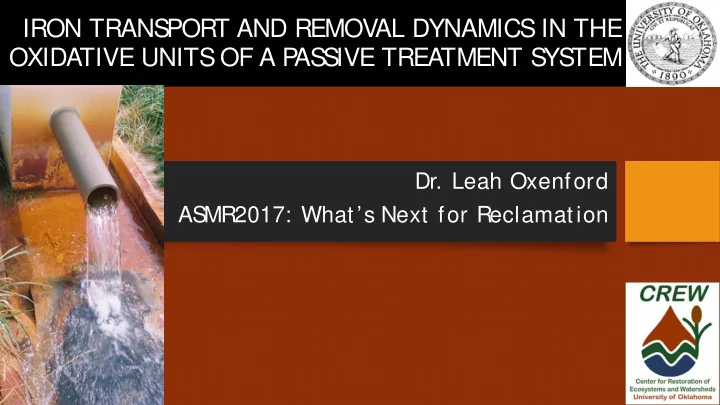

IRON TRANS PORT AND REMOVAL DYNAMICS IN THE OXIDATIVE UNITS OF A P AS S IVE TREATMENT S YS TEM Dr. Leah Oxenford AS MR2017: What’s Next for Reclamation
Average S ystem Influent Water Quality (3 seeps) n= 40 2004-2008 pre system construction • Q varies seasonally Component Concentration 400-700 L\min annually Iron 191.0 ± 10 mg/ L • Influent pH Zinc 9.65 ± 1.0 mg/ L 5.95 ± 0.06 Manganese 1.60 ± 0.1 mg/ L • Net Alkaline Lead 62 ± 13 µg/ L 393 ± 13 mg\L CaCO 3 Cadmium 15 ± 5 µg/ L
Understanding Iron Chemistry • Iron removal and storage within oxidative cells is based on two distinct processes: Fe 2+ oxidized t o Fe 3+ • Iron Oxidation – Oxidation is the rate determining step. 4Fe 2+ + O 2 + 4H + 4Fe 3+ + 2H 2 0 Rate influenced by iron • Iron Hydrolysis : Iron Precipit at ion concentration, pH, dissolved Fe 3+ + 3H 2 0 Fe(OH) 3 (s) + 3H + oxygen, and temperature.
MRPTS Improves Water Quality of Tributary Tributary Fe Loading Before System Installation: 71.3 kg Fe/day average After System Installation: 0.30 kg Fe/day
MRPTS Fe Removal Oxidative Unit • Cell 1 • Removes 87 kg/ day • Cell 2S / S N • Removes 17.3 kg/ day
Iron Removal Efficiency Profiling • To determine the spat ial dist ribution of iron removal, sedimentation, and storage over time. • Provides essential insight into how the design of the treatment cell may be refined to optimize processes favoring iron removal enhancement. • existing design • design of future passive treatment systems
Building Progressive Removal Profile: • Horizontal Component • S ample locations with increasing distance (time) from influent • Vertical Component • S ample locations with increasing depth from surface • Temporal Component • S ample collection with increasing time (seasonal, annual, 3-5 years)
Progressive Iron Removal Dynamics • Progressive Removal
Accumulation of Fe (2008-2015) • Accumulation
Average Accumulation Depth Decreases With Increasing HRT within The Oxidative Unit
Solids Characterization • Increased with HRT: • Particle size Crystallinity • Only crystallinity increased with increasing depth
Amorphous vs Crystalline
Crystalline Goethite Formation • Orthorhombic crystals observed in S EM • RAMAN microscopy verified as Goethite • Principle mineral phase
S olids Accumulation Inspires Rhodamine Tracer S tudy (2009-2015)
Rhodamine Tracer Study: (2015) Cell 1 • Tracer S tudy
Rhodamine Tracer Study: (2015) Cells 2 • Tracer S tudy
S ignificance of Work • Iron oxyhydroxide precipitates formed from the oxidation and hydrolysis of Fe 2+ accumulate within the preliminary oxidation cell (Cell 1) and the surface flow wetlands (Cells 2N/ 2S ) of MRPTS . • The accumulation of iron oxyhydroxides is not uniformly distributed within each cell, with the first section of the cell favoring deeper deposits of material. • Thus far, performance has not been inhibited by solids accumulation, but hydraulic conductivity of Cells 3N/ 3S impact HRT and water levels in the oxidative unit.
Comments / Questions?
Recommend
More recommend